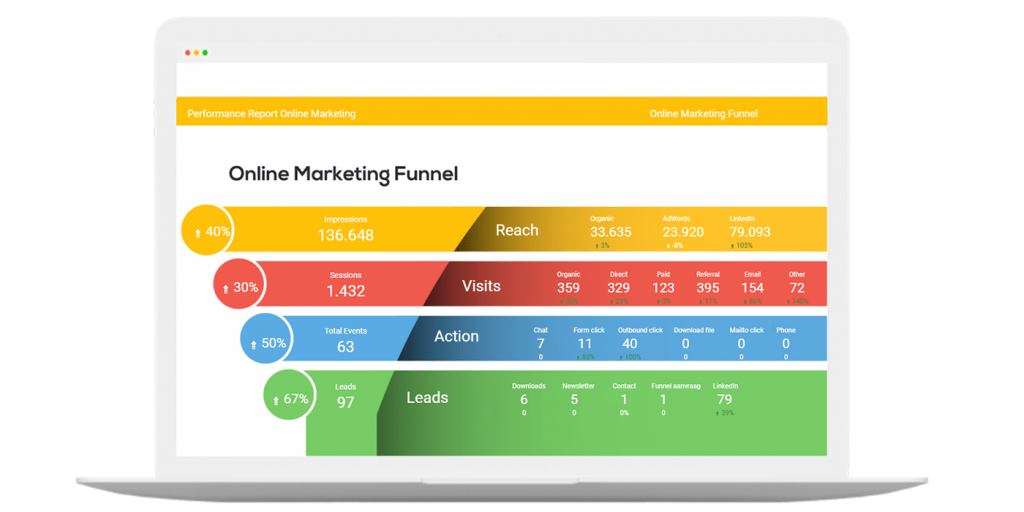ROI based marketing is a theory that takes the ROI (return on investment) as a starting point for whether or not to make marketing expenditures. On the one hand, this makes sense, because you naturally want to make a profit at the bottom of the line on the investment(s) you make. On the other hand, we still see that many IT organizations see it as a challenge to make lead generation successfully measurable. In this blog, we give you a roadmap to apply ROI based marketing.
Why ROI based amrketing is 'hot'
There are several reasons why ROI based marketing is currently a hot topic for IT organizations. We will discuss a number of them below.
COVID pandemic
It is no surprise to anyone that the COVID pandemic has had a negative economic impact on the entire Dutch business community. This is also forcing many IT organizations to turn over every extra euro before it is invested. While lead generation is precisely a way to bring in customers, every marketing euro spent must also be accounted for.
The developments have forced marketers to look at data from a different perspective and use it in a different way.
Data driven society
Partly due to the advent of the internet, much more data is available about a company’s internal processes and activities. This also applies to marketing. Advertising through platforms such as LinkedIn, Google and Facebook, for example, provides you with extensive data on all your campaigns. The same applies to using a marketing automation system. The data from all emails sent is immediately accessible. All these data sources can then be conveniently imported into an online dashboard such as Google Data Studio.
Growing competition
The fact that potential customers are also much easier to approach via the internet means that the number of IT organizations also continues to grow. This leads to IT organizations having to take a controlled approach to competition, including when it comes to marketing. Here it is essential that your marketing expenditures makes a positive contribution to the final revenue.
What you need to apply ROI based marketing
What exactly do you need to apply ROI based marketing? Below we describe several important requirements.
Someone who makes the decision
The decision, to use marketing ROI to guide marketing activities, often comes from the owner of an IT organization or the marketing manager. It is important that the person making the decision also convinces all parties involved (colleagues, agencies you work with) of the benefits. So as the decision maker, make sure you adopt ROI-based marketing appropriately within your IT organization.
Collaboration between marketing and sales
It is also important that the marketing and sales team of your IT organization work closely together. On the one hand, you want feedback from sales on the generated leads in order to steer as many results as possible at the bottom of the line. On the other hand, you want to know from sales whether a specific lead has become a customer. This makes it possible to calculate the marketing ROI of your marketing spend.
Insight into the lead generation and lead nurturing process
In addition to the collaboration between your marketing and sales team, you also want to have all data available about the entire lead generation and lead nurturing process. You can do this by merging together data from different channels in a clear dashboard. Below is an example of how we do this for our IT clients.

In addition, it is important that your sales team actively uses a CRM system to indicate the status of leads. At Leadgate Europe, for example, we forward all generated leads through Google Ads, LinkedIn Ads and the website to the marketing automation system. We can then link this back to the customer’s CRM system, mapping the entire customer journey from impression to conversion.
How do you calculate marketing ROI?
You now know why ROI based marketing is ‘hot’ and what you need, but how exactly do you calculate the marketing ROI? ROI is the expected revenue from an expense minus the costs of that expense and the result divided by the cost. Marketing ROI is the marketing variant: the expected revenue minus the marketing expense and dividing that result by the marketing expense. Below is a concrete example of how to calculate marketing ROI.
Example:
IT organization Workplace sells digital workplace solutions. They want to know when the use of Google Ads is successful. The status of all generated leads is tracked in Salesforce. As a result, the marketing and sales team sees that on average for every 100 Google Ads leads (at €50 per lead), 2 leads actually become customers. The conversion rate is 2%. The average order value is €8,000 per new customer. The marketing ROI can now be calculated as follows:
€ 16,000 (investment revenue) – € 5,000 (investment cost) : € 5,000 (cost investment x 100%) = an ROI of 220%.
For every euro that Workplace invests in Google Ads, they get €2.20 in return. So, by applying ROI-based marketing, you can make a responsible choice to invest X amount in your online channels.
How does Leadgate help?
Do you also want your IT organization to make a responsible choice regarding your marketing investments? We make the data of your IT organization’s lead generation process transparent through an online marketing funnel. Still have questions? Feel free to contact our specialists via info@leadgate.eu or 010 268 1148.






